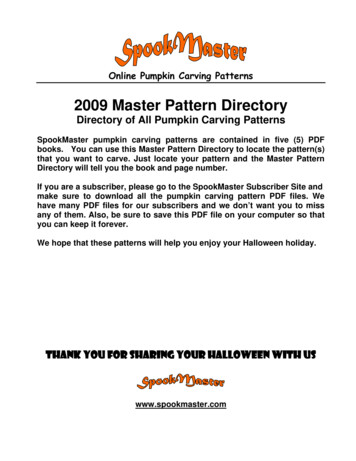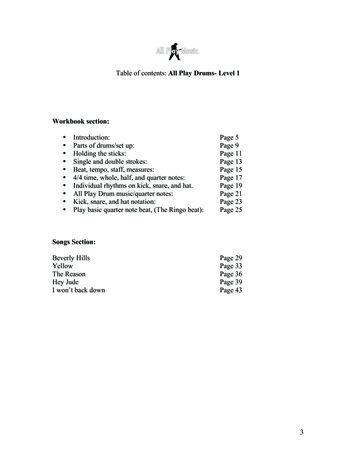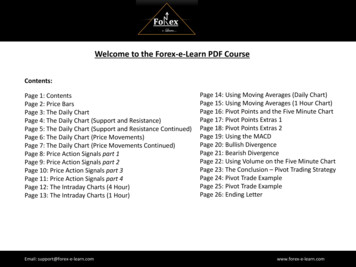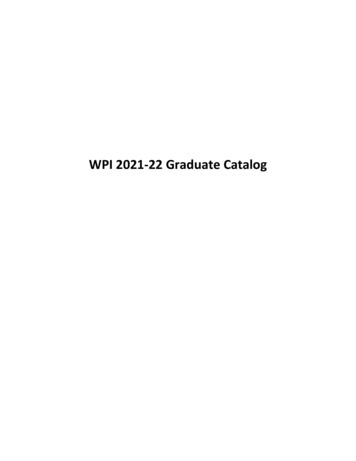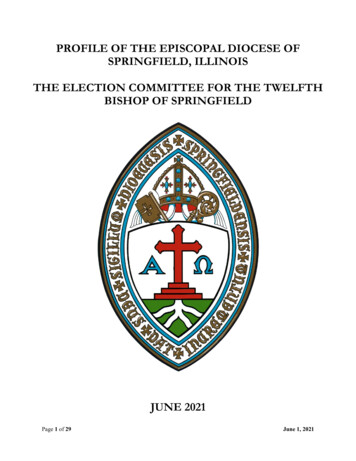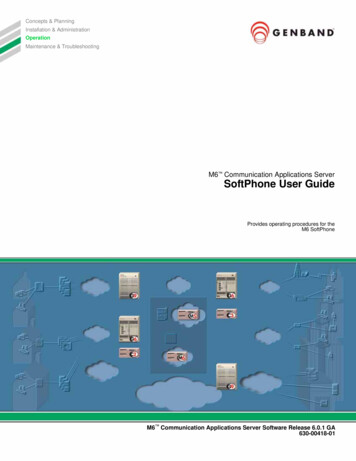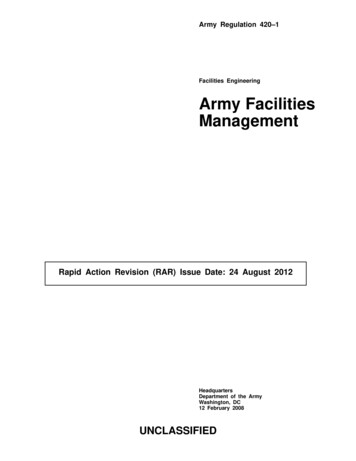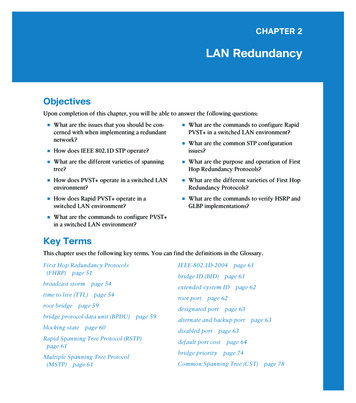
Transcription
tw book.book Page ix Tuesday, October 18, 2011 10:07 AMCONTENTS IN DETAILPREFACExviiAcknowledgments . xix1S E C U R IT Y I N T H E W O R L D O F W E B A P P L IC A T I O N S1Information Security in a Nutshell . 1Flirting with Formal Solutions . 2Enter Risk Management. 4Enlightenment Through Taxonomy . 6Toward Practical Approaches . 7A Brief History of the Web . 8Tales of the Stone Age: 1945 to 1994 . 8The First Browser Wars: 1995 to 1999 . 10The Boring Period: 2000 to 2003 . 11Web 2.0 and the Second Browser Wars: 2004 and Beyond . 12The Evolution of a Threat. 14The User as a Security Flaw. 14The Cloud, or the Joys of Communal Living. 15Nonconvergence of Visions . 15Cross-Browser Interactions: Synergy in Failure . 16The Breakdown of the Client-Server Divide . 17P A R T I : A NA T O M Y O F T H E W E B2IT S TA R T S W I T H A U R L2123Uniform Resource Locator Structure. 24Scheme Name . 24Indicator of a Hierarchical URL . 25Credentials to Access the Resource. 26Server Address . 26Server Port . 27Hierarchical File Path. 27Query String. 28Fragment ID. 28Putting It All Together Again . 29Reserved Characters and Percent Encoding . 31Handling of Non-US-ASCII Text. 32Common URL Schemes and Their Function. 36Browser-Supported, Document-Fetching Protocols . 36Protocols Claimed by Third-Party Applications and Plug-ins. 36Nonencapsulating Pseudo-Protocols. 37Encapsulating Pseudo-Protocols . 37Closing Note on Scheme Detection . 38The Tangled Web 2011 by Michal Zalewski
tw book.book Page x Tuesday, October 18, 2011 10:07 AMResolution of Relative URLs . 38Security Engineering Cheat Sheet. 40When Constructing Brand-New URLs Based on User Input . 40When Designing URL Input Filters . 40When Decoding Parameters Received Through URLs . 403H YP E R T E X T T R A N S F E R P R O T O C O L41Basic Syntax of HTTP Traffic . 42The Consequences of Supporting HTTP/0.9 . 44Newline Handling Quirks. 45Proxy Requests. 46Resolution of Duplicate or Conflicting Headers. 47Semicolon-Delimited Header Values. 48Header Character Set and Encoding Schemes . 49Referer Header Behavior . 51HTTP Request Types . 52GET. 52POST . 52HEAD . 53OPTIONS. 53PUT . 53DELETE . 53TRACE . 53CONNECT . 54Other HTTP Methods . 54Server Response Codes. 54200–299: Success . 54300–399: Redirection and Other Status Messages. 55400–499: Client-Side Error . 55500–599: Server-Side Error . 56Consistency of HTTP Code Signaling . 56Keepalive Sessions . 56Chunked Data Transfers . 57Caching Behavior . 58HTTP Cookie Semantics. 60HTTP Authentication. 62Protocol-Level Encryption and Client Certificates . 64Extended Validation Certificates. 65Error-Handling Rules . 65Security Engineering Cheat Sheet. 67When Handling User-Controlled Filenames in Content-Disposition Headers . 67When Putting User Data in HTTP Cookies. 67When Sending User-Controlled Location Headers . 67When Sending User-Controlled Redirect Headers. 67When Constructing Other Types of User-Controlled Requests or Responses. 67xContents in D e ta i lThe Tangled Web 2011 by Michal Zalewski
tw book.book Page xi Tuesday, October 18, 2011 10:07 AM4H YP E R T E X T M A RK U P L A NGU AG E69Basic Concepts Behind HTML Documents . 70Document Parsing Modes. 71The Battle over Semantics . 72Understanding HTML Parser Behavior . 73Interactions Between Multiple Tags . 74Explicit and Implicit Conditionals. 75HTML Parsing Survival Tips. 76Entity Encoding . 76HTTP/HTML Integration Semantics. 78Hyperlinking and Content Inclusion . 79Plain Links . 79Forms and Form-Triggered Requests. 80Frames. 82Type-Specific Content Inclusion . 82A Note on Cross-Site Request Forgery. 84Security Engineering Cheat Sheet. 85Good Engineering Hygiene for All HTML Documents . 85When Generating HTML Documents with Attacker-Controlled Bits . 85When Converting HTML to Plaintext . 85When Writing a Markup Filter for User Content . 865CASCADING STYLE SHEETS87Basic CSS Syntax . 88Property Definitions . 89@ Directives and XBL Bindings . 89Interactions with HTML . 90Parser Resynchronization Risks. 90Character Encoding. 91Security Engineering Cheat Sheet. 93When Loading Remote Stylesheets . 93When Putting Attacker-Controlled Values into CSS . 93When Filtering User-Supplied CSS. 93When Allowing User-Specified Class Values on HTML Markup . 936BROWSER-SIDE SCRIPTS95Basic Characteristics of JavaScript. 96Script Processing Model . 97Execution Ordering Control . 100Code and Object Inspection Capabilities . 101Modifying the Runtime Environment . 102JavaScript Object Notation and Other Data Serializations . 104E4X and Other Syntax Extensions. 106The Tangled Web 2011 by Michal ZalewskiContents in D etai lxi
tw book.book Page xii Tuesday, October 18, 2011 10:07 AMStandard Object Hierarchy . 107The Document Object Model . 109Access to Other Documents . 111Script Character Encoding. 112Code Inclusion Modes and Nesting Risks . 113The Living Dead: Visual Basic . 114Security Engineering Cheat Sheet. 115When Loading Remote Scripts . 115When Parsing JSON Received from the Server . 115When Putting User-Supplied Data Inside JavaScript Blocks . 115When Interacting with Browser Objects on the Client Side . 115If You Want to Allow User-Controlled Scripts on Your Page . 1167N O N - H TM L D O C U M E N T T Y P E S117Plaintext Files . 117Bitmap Images . 118Audio and Video . 119XML-Based Documents . 119Generic XML View . 120Scalable Vector Graphics. 121Mathematical Markup Language. 122XML User Interface Language. 122Wireless Markup Language. 123RSS and Atom Feeds . 123A Note on Nonrenderable File Types . 124Security Engineering Cheat Sheet. 125When Hosting XML-Based Document Formats . 125On All Non-HTML Document Types. 1258C O N TE N T R E N D E R I NG WI T H BR O WS E R PL U G - IN S127Invoking a Plug-in. 128The Perils of Plug-in Content-Type Handling . 129Document Rendering Helpers. 130Plug-in-Based Application Frameworks . 131Adobe Flash . 132Microsoft Silverlight . 134Sun Java . 134XML Browser Applications (XBAP) . 135ActiveX Controls. 136Living with Other Plug-ins . 137Security Engineering Cheat Sheet. 138When Serving Plug-in-Handled Files . 138When Embedding Plug-in-Handled Files . 138If You Want to Write a New Browser Plug-in or ActiveX Component . 138xiiC on t e n t s i n D e t a i lThe Tangled Web 2011 by Michal Zalewski
tw book.book Page xiii Tuesday, October 18, 2011 10:07 AMPART II: BROWSER SECURITY FEATURES9C O N TE N T I S O L AT IO N L O G IC139141Same-Origin Policy for the Document Object Model . 142document.domain . 143postMessage(.) . 144Interactions with Browser Credentials. 145Same-Origin Policy for XMLHttpRequest . 146Same-Origin Policy for Web Storage . 148Security Policy for Cookies . 149Impact of Cookies on the Same-Origin Policy. 150Problems with Domain Restrictions. 151The Unusual Danger of “localhost” . 152Cookies and “Legitimate” DNS Hijacking. 153Plug-in Security Rules . 153Adobe Flash . 154Microsoft Silverlight . 157Java . 157Coping with Ambiguous or Unexpected Origins . 158IP Addresses . 158Hostnames with Extra Periods . 159Non–Fully Qualified Hostnames . 159Local Files . 159Pseudo-URLs . 161Browser Extensions and UI . 161Other Uses of Origins . 161Security Engineering Cheat Sheet. 162Good Security Policy Hygiene for All Websites . 162When Relying on HTTP Cookies for Authentication . 162When Arranging Cross-Domain Communications in JavaScript . 162When Embedding Plug-in-Handled Active Content from Third Parties . 162When Hosting Your Own Plug-in-Executed Content. 163When Writing Browser Extensions . 16310O R IG I N I N H E R IT A N C E165Origin Inheritance for about:blank . 166Inheritance for data: URLs. 167Inheritance for javascript: and vbscript: URLs . 169A Note on Restricted Pseudo-URLs . 170Security Engineering Cheat Sheet. 17211L I F E O U T S I D E S A M E - O R I G IN R U L E S173Window and Frame Interactions . 174Changing the Location of Existing Documents . 174Unsolicited Framing. 178The Tangled Web 2011 by Michal ZalewskiContents i n Detailxiii
tw book.book Page xiv Tuesday, October 18, 2011 10:07 AMCross-Domain Content Inclusion . 181A Note on Cross-Origin Subresources. 183Privacy-Related Side Channels . 184Other SOP Loopholes and Their Uses . 185Security Engineering Cheat Sheet. 186Good Security Hygiene for All Websites . 186When Including Cross-Domain Resources . 186When Arranging Cross-Domain Communications in JavaScript . 18612O T H E R S E C U R I T Y B O U N D A R IE S187Navigation to Sensitive Schemes. 188Access to Internal Networks. 189Prohibited Ports . 190Limitations on Third-Party Cookies. 192Security Engineering Cheat Sheet. 195When Building Web Applications on Internal Networks. 195When Launching Non-HTTP Services, Particularly on Nonstandard Ports . 195When Using Third-Party Cookies for Gadgets or Sandboxed Content . 19513C O N TE N T R E C O G N IT IO N M E CH A N I S M S197Document Type Detection Logic. 198Malformed MIME Types . 199Special Content-Type Values. 200Unrecognized Content Type . 202Defensive Uses of Content-Disposition . 203Content Directives on Subresources . 204Downloaded Files and Other Non-HTTP Content . 205Character Set Handling . 206Byte Order Marks . 208Character Set Inheritance and Override . 209Markup-Controlled Charset on Subresources. 209Detection for Non-HTTP Files. 210Security Engineering Cheat Sheet. 212Good Security Practices for All Websites. 212When Generating Documents with Partly Attacker-Controlled Contents . 212When Hosting User-Generated Files . 21214D E A L I N G W IT H R O GU E S C R IP T S213Denial-of-Service Attacks . 214Execution Time and Memory Use Restrictions . 215Connection Limits . 216Pop-Up Filtering . 217Dialog Use Restrictions. 218Window-Positioning and Appearance Problems . 219Timing Attacks on User Interfaces . 222xivContents in D e ta i lThe Tangled Web 2011 by Michal Zalewski
tw book.book Page xv Tuesday, October 18, 2011 10:07 AMSecurity Engineering Cheat Sheet. 224When Permitting User-Created iframe Gadgets on Your Site . 224When Building Security-Sensitive UIs . 22415EX TR I NSI C S IT E P R IV ILE G ES225Browser- and Plug-in-Managed Site Permissions . 226Hardcoded Domains . 227Form-Based Password Managers. 227Internet Explorer’s Zone Model . 229Mark of the Web and Zone.Identifier . 231Security Engineering Cheat Sheet. 232When Requesting Elevated Permissions from Within a Web Application . 232When Writing Plug-ins or Extensions That Recognize Privileged Origins. 232PART III: A GLIMPSE OF THINGS TO COME16NE W A ND U PC O M ING S E C U R I TY FE A TU R E S233235Security Model Extension Frameworks . 236Cross-Domain Requests . 236XDomainRequest . 239Other Uses of the Origin Header . 240Security Model Restriction Frameworks . 241Content Security Policy. 242Sandboxed Frames . 245Strict Transport Security. 248Private Browsing Modes. 249Other Developments . 250In-Browser HTML Sanitizers. 250XSS Filtering . 251Security Engineering Cheat Sheet. 25317OTHER BROWSER MECHANISMS OF NOTE255URL- and Protocol-Level Proposals . 256Content-Level Features. 258I/O Interfaces . 25918C O M M O N W E B V U L N E RA B I L I T I E S261Vulnerabilities Specific to Web Applications. 262Problems to Keep in Mind in Web Application Design. 263Common Problems Unique to Server-Side Code . 265The Tangled Web 2011 by Michal ZalewskiC on t e n t s i n D e t a i lxv
tw book.book Page xvi Tuesday, October 18, 2011 10:07 AMEPILOGUE267N O TE S269INDEX273xviContents in D e ta i lThe Tangled Web 2011 by Michal Zalewski
tw book.book Page 41 Tuesday, October 18, 2011 10:07 AMHYPERTEXT TRANSFERPROTOCOLThe next essential concept we need to discuss is theHypertext Transfer Protocol (HTTP): the core transfer mechanism of the Web and the preferred methodfor exchanging URL-referenced documents betweenservers and clients. Despite having hypertext in itsname, HTTP and the actual hypertext content (theHTML language) often exist independent of eachother. That said, they are intertwined in sometimessurprising ways.The history of HTTP offers interesting insight into its authors’ ambitionsand the growing relevance of the Internet. Tim Berners-Lee’s earliest 1991draft o
HYPERTEXT TRANSFER PROTOCOL The next essential concept we need to discuss is the Hypertext Transfer Protocol (HTTP): the core trans-fer mechanism of the Web and the preferred method
